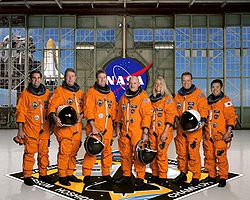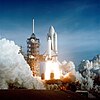STS-124
| Mission emblem | |||
|---|---|---|---|

|
|||
| Mission dates | |||
| Mission: | STS-124 | ||
| COSPAR-ID : | 2008-27A | ||
| Crew: | 7th | ||
| Begin: | May 31, 2008, 21:02:12 UTC | ||
| Starting place: | Kennedy Space Center , LC-39A | ||
| Space station: | ISS | ||
| Coupling: | June 2, 2008, 18:03 UTC | ||
| Decoupling: | June 11, 2008, 11:42 UTC | ||
| Duration on the ISS: | 8d 17h 39 min | ||
| Number of EVA : | 3 | ||
| Landing: | June 14, 2008, 15:14 UTC | ||
| Landing place: | Kennedy Space Center, Lane 15 | ||
| Flight duration: | 13d 18h 12min | ||
| Earth orbits: | 217 | ||
| Rotation time : | 91 min 20 s | ||
| Track height: | 340 km | ||
| Covered track: | 9.2 million km | ||
| Payload: | JEM-PM, JEM-RMS | ||
| Team photo | |||
 v. l. From right: Gregory Chamitoff, Michael Fossum, Kenneth Ham, Mark Kelly, Karen Nyberg, Ronald Garan, Akihiko Hoshide |
|||
| ◄ Before / After ► | |||
|
|||
STS-124 (English S pace T ransportation S ystem) is the mission name for a flight of the US space shuttle Discovery (OV-103) of NASA . It was the 123rd space shuttle mission, the 35th flight of the space shuttle Discovery and the 26th flight of a space shuttle to the International Space Station (ISS) . The launch took place on May 31, 2008.
team
- Mark Kelly (3rd space flight), commander
- Kenneth Ham (1st spaceflight), pilot
- Karen Nyberg (1st Space Flight), Mission Specialist
- Ronald Garan (1st spaceflight), mission specialist
- Michael Fossum (2nd space flight), mission specialist
-
Akihiko Hoshide (1st space flight), Mission Specialist ( JAXA / Japan )

ISS crew outward flight
ISS expedition 17 / ISS expedition 18
- Gregory Chamitoff (1st spaceflight), flight engineer
ISS crew return flight
ISS expedition 16 / ISS expedition 17
- Garrett Reisman (1st spaceflight), flight engineer
Mission overview
The STS-124 mission brought another part of the Japanese Kibō module (Japanese Experiment Module - Pressurized Module; JEM-PM) and the Japanese robotic arm (JEM-RMS) to the International Space Station (ISS). In addition, the ELM-PS module supplied with the STS-123 was moved to its final position.
Preparations
The Discovery was driven to the Orbiter Processing Facility (OPF) shortly after returning from its last mission ( STS-120 ) on November 7, 2007 . There the follow-up inspection of the orbiter and the preparation for STS-124 took place.
The outer tank arrived at the Kennedy Space Center (KSC) on March 25, 2008 . This was brought to the Vehicle Assembly Building (VAB) to be connected to the two solid fuel rockets required for launch .
On April 26, the Discovery was transported from the OPF hangar to the VAB. After assembly with the external tank and solid fuel boosters, the orbiter was rolled to launch pad 39A on May 3rd. Following the last of two readiness acceptance conferences on May 19, NASA confirmed May 31 as the official launch date. Two days before take-off, a new toilet pump for the ISS was added to the payload after the ISS's old toilet had failed a few days earlier. A few hours after the crew from Houston arrived at KSC on May 28, the countdown for STS-124 began.
Mission history
Launch, inspection and coupling
At 22:30 UTC on May 30, the RSS (Rotating Service Structure) work platform was moved into its parking position. Filling of the external tank began on May 31 at 11:30 UTC. As on the last mission, the ECO sensors worked without any problems. After the traditional breakfast, the crew went to launch pad 39A at around 17:00 UTC and boarded the shuttle. The weather did not cause any problems, so the Discovery was able to take off as scheduled at 21:02 UTC. The solid-fuel rockets were dropped two minutes after take-off, and the external tank six and a half minutes later. After opening the cargo bay doors 90 minutes after take-off, the crew noticed a slightly torn heat protection mat on the left OMS gondola. However, it was found that this did not affect re-entry. Furthermore, the backup system for moving the starboard engine failed; however, the main system continued to work fine, so no further problems arose.
On takeoff, several pieces of the insulating foam came off the tank and hit the Discovery. However, during the rendezvous pitch maneuver on the third day of flight to investigate the heat protection, no significant damage was found. On the other hand, the launch pad suffered severe damage. As with several other launches, concrete slabs covering the launch system were pushed out. What was unusual, however, was that several fireclay bricks in a fire shaft of the launch system were destroyed on take-off and, as a rain of debris, destroyed a separating fence. No people were harmed in the incident and the Discovery is said to have not been damaged either. During the preparation phase on STS-125 , the aim was to find out what exactly triggered the incident; the necessary repairs should also be made.
On the second day of the flight, an inspection of the heat shield was carried out, but only with the camera at the end of the robot arm of the shuttle. This happened because the main module of Kibō is too large to simultaneously take the Orbiter Boom Sensor System (OBSS) in the payload bay with which this investigation is normally carried out.
After a two-day approach and the rendezvous pitch maneuver, the Discovery docked with the ISS on June 2 at 18:03 UTC. After the safety briefing and a tour of the station, preparations began on the first spacewalk (EVA) on the following day. Gregory Chamitoff also switched to the Expedition 17 team for Garrett Reisman by replacing the tailor-made Soyuz seats. In the evening, Fossum and Garan went to the Quest station airlock to breathe pure oxygen overnight under reduced pressure. During this so-called campout, nitrogen is removed from the body tissue of the space travelers in order to prevent negative pressure sickness.
Working on the ISS
On the fourth day of flight, the mission's first spacecraft began at 16:22 UTC. During the deployment of Michael Fossum and Ronald Garan, the OBSS was first disconnected from the station and transferred to the shuttle's robot arm. This was not electrified for 30 minutes. The low temperatures of space could have damaged the robot arm extension after about two hours. Then Fossum and Garan went to the Kibō module located in the cargo bay of the shuttle to prepare it for transfer to the port docking nozzle of the Harmony module. After this was done, Kibo was brought to his place on Harmony by Karen Nyberg and Akihiko Hoshide. During this time the two mission specialists went to the S4 grid structure. There, Garan replaced a motor on the SARJ swivel joint while Fossum tried to remove space dust that had accumulated on one of the swivel rings using various tools and techniques. This should help refine techniques for the STS-126 mission to repair the SARJ during that mission. The swivel joint showed signs of wear in 2007, which were expressed by vibrations throughout the station. Since then the swivel joint was mostly switched off and was only moved as much as was absolutely necessary. The SARJ aligns the large solar cells with the sun in order to convert as much solar energy as possible into electrical energy. The exit ended after six hours and 48 minutes at 23:10 UTC.
On the fifth day of the flight, the hatches to Kibo were opened at 21:05 UTC and, after an air inspection, the interior of the still empty module was started. Furthermore, preparations were made for the second exit and Fossum and Garan went to another campout. In addition, the defective space toilet in the Russian Zvezda module was repaired.
During the EVA on the sixth day of flight, which began at 15:04 UTC and lasted seven hours and eleven minutes, the Japanese robotic arm was prepared for commissioning. Cameras were also installed on the outside of the new module and a defective camera was brought to the station for repair. Furthermore, the logistics module delivered by STS-123 was prepared for its implementation on the following day as well as the assembly of a nitrogen tank during the last exit.
Flight day seven was initially used to move the Kibō logistics module to its new location on the main module. After installing the module, the interior work was continued. Furthermore, the Japanese robot arm was moved a little for the first time, but not extended.
After a rest day on the eighth day of flight, which ended with the preparations for the last spacecraft mission, Fossum and Garan disembarked from the station for the last time on the ninth day of flight at 13:55 UTC. With a "windshield wiper maneuver" with guarantee at the end of the Canadarm2, the empty nitrogen tank in the starboard carrier was exchanged for a newly filled one from the warehouse in the port carrier, the camera mounting of a Kibo external camera was checked, the repaired camera system was mounted on the P1 carrier again, protective covers on the cameras of the Japanese robotic arm removed and comparative samples taken from the intact port SARJ. The exit ended after six hours and 33 minutes at 20:28 UTC.
After the minimal movement of two joints of the ten-meter-long Kibō robotic arm on the seventh day of flight, the tenth day, in addition to preparations for the return of the Discovery, served to fully commission the arm. All six joints and the associated brakes worked perfectly.
return
Discovery undocked from the ISS on June 11 at 11:42 UTC. The ISS was then flown around once and the heat shield was checked with the Orbiter Boom Sensor System (OBSS), as this was not possible as usual on the second day of flight due to the size of the payload. Flight day 13 was mainly used to relax the crew before reentry and landing. Only the OBSS was stowed in the payload bay and the orbit was stabilized by an ignition. On the 14th day of the flight, the crew prepared themselves and the orbiter for landing. The systems that are important for the landing were checked and found to be functional.
On June 14th (flight day 15) the gates of the payload bay were closed and the preparations for landing ended. At 14:10 UTC, the Deorbit Burn was carried out as planned and the landing at KSC was initiated. The mission control decided to land on taxiway 15, which is in the direction of 150 °, i.e. H. runs from the north-west to the south-east, as otherwise sun rays might have made the approach difficult for the commander. Exactly at 15:14 UTC, the Discovery landed at the Kennedy Space Center in Florida after 217 orbits. The Discovery was later moved to the Orbiter Processing Facility , where it was prepared for its next mission ( STS-119 ).
See also
- List of space shuttle missions
- List of manned missions to the International Space Station
- List of unmanned missions to the International Space Station
Web links
- NASA: Future Shuttle Missions
- NASA: Official Mission Site (English)
- NASA: Mission Photo Gallery
- Video summary with comments of the crew (English)
- Space Science Journal: Mission STS-124









